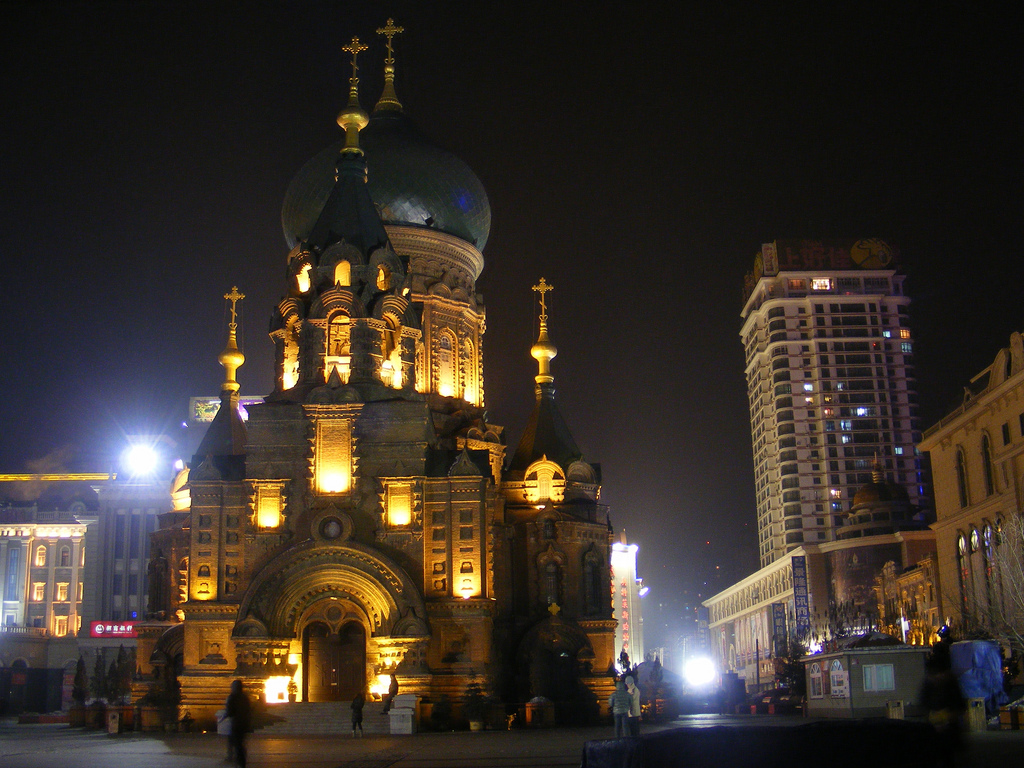
The Cathedral monument is a sign of the important presence of the Orthodox Church in China and recent closer political relations between Beijing and Moscow.
Beijing (AsiaNews/Agencies) – Harbin’s Orthodox Cathedral of St Sophia has been included in the first edition of the 20th century Chinese architectural heritage list along with 97 other sites.
The China Cultural Relic Association and the Architectural Society of China issued the list on 29 September, the Heilongjiang Daily reported. Other landmarks include the Great Hall of the People, the Shanghai Park Hotel and the Wuhan Yangtze River Bridge.
Experts say that the reason for this list is that these monuments witnessed Chinese history in the 20th century, representing the historical context of China’s social development and architecture in the last century.
The Russian-style cathedral was made from timber in March 1907 as part of a plan to reconsolidate the confidence of the Russian No.4 Army Division by building an imposing spiritual symbol.
The 53.3-metre-high cathedral covers an area of 721 m2 and is the perfect example of Neo-Byzantine architecture. Under the bright sun, the church and the square look like Moscow’s Red Square.
In 1996, the building was listed as an national cultural heritage site. A year later, the municipal government repaired and renovated the cathedral and its surrounding environment to grant it landmark status.
About 13,000 Orthodox Christians live in China, mostly in Heilongjiang, Harbin, Inner Mongolia (Labdarin) and Xinjiang (Kulj and Urumqi).
In 2013 Russian Orthodox Patriarch Kirill was received for the first time by President Xi in the Great Hall of the People in Beijing.
In 2015, for the first time in 60 years, the People’s Republic authorised the ordination of Chinese Orthodox priests.
In meeting with Kirill, Xi Jiping praised the role of “culture, traditions and the moral factor in shaping the lives of people and individuals.”
Harbin cathedral is not only the religious symbol of the Orthodox Church in China, but also has political importance as a symbol of Sino-Russian relations.

Well, considering what the place looked like during the eighties when my wife Cheryl and I taught English in Harbin, this is great news. Back then I would give foreigners and others my own tour of parts of the city so they could learn what things used to be. No buildings were labeled with their original use and there were no tours besides mine or even a tourist book. I’d always take my group to see this building that was then used for a warehouse. At the time, the windows and all the doors but one were filled with bricks and the crosses were gone.
One day in 1989, I was walking with a couple of young Soviets that were studying Mandarin at Heilongjiang University and a young American woman. The two Soviets (both named Alexander) were the only two from the U.S.S.R. that were unafraid to spend time with Americans on their own. We were able to get into Sophiski, thanks to a kind worker there, through the only unbricked-in door (at the east end of the building.) In other pictures you can see a ladder going up the west side of the tower to a small platform at the base of the big dome. One of the Alexander’s went up and after he came down, I went up there. The view was great – we could see the tall Stalinesque main building of Harbin Institute of Technology where Cheryl and I worked for four years. I was also able to walk on the catwalk inside the tower, just below the windows. The space between the floor and the dome was impressive.
In 1990, I was working at the U.S. consulate in Shenyang when Ambassador James Lilly and a few of us visited Harbin. I gave a tour, this time in a coach that our Chinese friends contributed. I took everyone to see the former Holy Wisdom Orthodox Church up close. Back then it was surrounded by apartment buildings and other structures. I explained one thing and another, using my Sydney Polytechnic Association Jubilee Edition book with many photos of Harbin back in Russian days. I always hoped that the building would be saved. It’s quite a sight now.
One point I must make about the use of the word “cathedral.” If you go to
St Nicholas Cathedral in Harbin
http://www.orthodox.cn/localchurch/harbin/nikolai_en.htm
You can read about Harbin’s only Russian Orthodox cathedral, St. Nicholas Cathedral. This was finished in 1900. It was located up the boulevard from the main train station. The first Holy Wisdom Church was built in Pristan (now Daoli District). The second (the one in the photo here) was built not far from the first one and was finished in the 1930’s. St. Nicholas Cathedral was destroyed by the Red Guards at the start of the Cultural Revolution in 1966. I had a student in 1985-6 that had been as Red Guard there when it happened. We were walking past the roundabout where the cathedral had stood when he mentioned it again. I asked what he thought about that now. He said, “Then I thought it was necessary. Now I think it was stupid.”